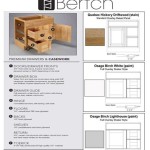Replacing Trim On Kitchen Cabinets: A Guide to Essential Aspects
Rejuvenating your kitchen cabinets with new trim can transform the overall look and feel of your space. Whether you're seeking a modern update or a classic touch, replacing the trim is an accessible project that can bring new life to your kitchen. Here's a comprehensive guide to the essential aspects of replacing trim on kitchen cabinets to ensure a successful and satisfying outcome:
1. Choosing the Right Trim:
The first step is selecting the appropriate trim that complements the style and design of your cabinets. Consider the thickness, width, and profile of the trim to ensure it aligns with the cabinet doors and drawer fronts. Explore a variety of materials such as wood, MDF, and plastic, each offering unique durability and aesthetic properties.
2. Removing Existing Trim:
Before installing new trim, it's essential to remove the existing trim carefully to avoid damaging the cabinet finish. Use a sharp utility knife or pry bar to gently separate the trim from the cabinet. Be cautious and take your time to prevent gouging or chipping the cabinet surface.
3. Measuring and Cutting New Trim:
Precise measurements are crucial for the proper fit of the new trim. Measure the length of each section where trim is required, allowing for slight overlaps at the corners. Transfer these measurements to the trim and mark the cutting lines. Use a miter saw or miter box and hand saw to create precise 45-degree angles for seamless corner connections.
4. Joining Trim Pieces:
Once the trim pieces are cut, it's time to join them together. Apply a thin layer of wood glue to the mitered edges and press them firmly into place. Reinforce the joints using small finish nails or a brad nailer, driving them into the trim at an angle for maximum hold.
5. Installing Trim on Cabinets:
With the trim pieces joined, you can install them on the cabinets. Apply a thin bead of construction adhesive to the back of the trim and carefully position it on the cabinet. Secure the trim with small finish nails or a brad nailer, ensuring they are spaced evenly apart for a professional finish.
6. Finishing Touches:
Once the trim is installed, use wood filler to fill any nail holes or gaps. Sand the filled areas smooth and wipe away any dust. Apply a coat of paint or stain to match the cabinetry, allowing ample drying time before handling the cabinets.
Conclusion:
Replacing trim on kitchen cabinets is a rewarding project that can enhance the aesthetic appeal and functionality of your kitchen. By following these essential aspects, you can confidently tackle this project and achieve a polished, professional finish. Whether you prefer bold colors or sleek profiles, the right trim can transform your kitchen into a space you'll love.

Adding Crown Molding To Cabinets Young House Love

Adding Moldings To Your Kitchen Cabinets Remodelando La Casa

Moldings Finish And Trim With Gary Striegler Part 14

How To Add Crown Molding Kitchen Cabinets Abby Organizes

Diy Cabinet End Panels With Shaker Style Trim Average But Inspired
.jpg?strip=all)
How To Remove Decorative Cabinet Scrollwork Dream Green Diy

How S That Project Holding Up Updated Kitchen Cabinets

Adding Moldings To Your Kitchen Cabinets Remodelando La Casa

Install Trim Above Cabinets Madness Method Kitchen Cabinet Crown Molding

Update Kitchen Cabinets For Diy Remodel
Related Posts








